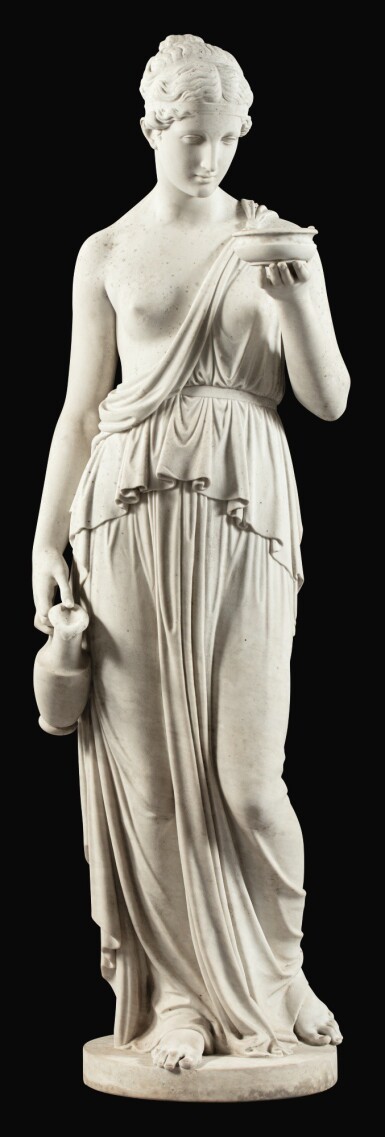Tableaux Dessins Sculptures 1300-1900
Tableaux Dessins Sculptures 1300-1900

ITALIAN, 19TH CENTURY, AFTER BERTEL THORVALDSEN (1770-1844) | HEBE
Auction Closed
December 3, 07:24 PM GMT
Estimate
15,000 - 20,000 EUR
Lot Details
Description
ITALIAN, 19TH CENTURY, AFTER BERTEL THORVALDSEN (1770-1844)
HEBE
white marble
H. 157 cm ; 91¾ in.
__________________________________________________________________
ITALIE, XIXE SIÈCLE, D'APRÈS BERTEL THORVALDSEN (1770-1844)
HÉBÉ
marbre blanc
H. 157 cm ; 91¾ in.
Related Literature
E. di Majo, B. Jørnaes, S. Susinno, Bertel Thorvaldsen 1770-1844 scultore danese a Roma, Italie, 1989, pp. 140-141, cat. n. 1;
S. Grandesso, Bertel Throvaldsen (1770-1844), Italie, 2015, pp. 131-132, figs. 166-167.
__________________________________________________________________
Références bibliographiques
E. di Majo, B. Jørnaes, S. Susinno, Bertel Thorvaldsen 1770-1844 scultore danese a Roma, Italie, 1989, pp. 140-141, cat. n. 1 ;
S. Grandesso, Bertel Throvaldsen (1770-1844), Italie, 2015, pp. 131-132, figs. 166-167.
Son of an Icelandic woodcarver, Thorvaldsen grew up in Copenhagen, where he was admitted to the Royal Academy of Fine Arts in 1781 to train as a sculptor. The young artist left for Rome in 1787, where he gravitated around the community of his fellow Danish emigrants. Among them were the antiquarian and scholar Jörgen Zoëga (1755-1809) and the painter and critic Asmus Jacob Carstens (1754-1798), both of whom had a considerable influence on Thorvaldsen's development as an artist, particularly with regard to his study of classical sculpture and the theories of the famous archaeologist Johan Joachim Winkelmann.
On the death of Antonio Canova in 1822, Thorvaldsen became the oldest and most respected sculptor in Rome, as confirmed by commissions such as the funerary monument to Pope Pius VII in St. Peter's Basilica (1823-31), and appointments such as the presidency of the prestigious Accademia di San Luca (1828), a position previously held by Canova.
Thorvaldsen was inspired by Canova's Hebe, executed between 1796 and 1799, to create his own representation of the Goddess of Youth in 1806, forming the counterpart to the Ganymede of 1804. He chose to capture her almost static, in a moment of contemplation of her cup evoking the myth of the goddess. Indeed, both Ganymede and Hebe had been chosen to serve the nectar of immortality to the Gods of Olympus. Unlike Ganymede, Hebe was clumsy and failed to serve the precious elixir properly.
Concerning the goddess's costume, Thorvaldsen made a polemical choice: she wears a mixture between the antique peplum originally fixed on both shoulders, and the short chiton which reveals a breast, in the manner of the Amazons. This choice of clothing was shocking, Zoëga is said to have pointed out to her: "No honest woman was dressed like this in Antiquity, let alone a goddess! " (E. di Majo, op. cit., p. 140). Thorvaldsen finally made a second version of this model in 1816, in which Hebe's chest is completely covered.
Today the original marble model is in the Thorvaldsen Museum (inv. no. A 875) acquired in 1936 from the Californian collector William Randolph Hearst.
__________________________________________________________________
Fils d'un sculpteur sur bois islandais, Thorvaldsen grandi à Copenhague, où il est admis en 1781 à l'Académie Royale des Beaux-Arts pour y suivre une formation de sculpteur. Le jeune artiste part pour Rome en 1787, où il gravite autour de la communauté de ses compatriotes émigrés danois. Parmi eux se trouvaient l'antiquaire et savant Jörgen Zoëga (1755-1809) et le peintre et critique Asmus Jacob Carstens (1754-1798), qui ont tous deux eu une influence considérable sur le développement de Thorvaldsen en tant qu'artiste, notamment en ce qui concerne son étude de la sculpture classique et des théories du célèbre archéologue Johan Joachim Winkelmann.
À la mort d’Antonio Canova en 1822, Thorvaldsen devient le sculpteur le plus ancien et le plus respecté de Rome, comme le confirment des commandes telles que le monument funéraire du Pape Pie VII dans la basilique Saint-Pierre (1823-31), et des nominations telles que la présidence de la prestigieuse Accademia di San Luca (1828), un poste précédemment occupé par Canova.
Thorvaldsen s’est inspiré de l’Hébé de Canova exécuté entre 1796 et 1799, pour réaliser sa propre représentation de la déesse de la Jeunesse en 1806, formant le pendant au Ganymède de 1804. Il choisit de la saisir presque statique, dans un moment de contemplation de sa coupelle évoquant le mythe de la déesse. En effet, Ganymède et Hébé avaient tous deux étaient choisi pour servir le nectar d’immortalité aux Dieux de l’Olympe. A la différence de Ganymède, Hébé, maladroite, n’a pas réussi à servir correctement le précieux élixir.
Concernant le costume de la déesse, Thorvaldsen a fait un choix polémique : elle revêt un mélange entre le péplum antique à l’origine fixé sur les deux épaules, et le chiton court qui laisse apercevoir un sein, à la manière des Amazones. Ce choix vestimentaire a choqué, Zoëga lui aurait notamment fait remarquer : « Aucune honnête femme été habillée comme cela dans l'Antiquité, encore moins une déesse ! » (E. di Majo, op. cit., p. 140). Thorvaldsen a finalement réalisé une deuxième version de ce modèle en 1816, où la poitrine d’Hébé est entièrement recouverte.
Aujourd’hui le modèle original en marbre se trouve au Musée Thorvaldsen (inv. no. A 875) acquis en 1936 auprès du collectionneur californien William Randolph Hearst.
